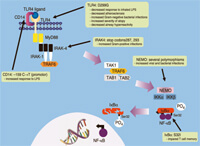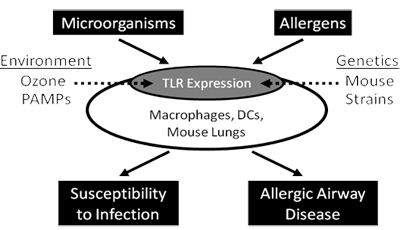Project Leaders: David A. Schwartz, MD and Ivana V. Yang, PhD
Project Personnel: Judy Oakes, PhD and Laura Warg
Background

The overall goal of this project is to understand how and why air pollution alters lung host defense. The environmental, clinical, and biological significance of this project is supported by the following observations. First, air pollution accounts for substantial morbidity and mortality throughout the world, including lung infections and preventable deaths in children. Second, endotoxin is ubiquitous in the environment and is associated with the development and progression of asthma and other forms of airway disease. Third, the ability of the host to respond to lipopolysaccharide and other PAMPs (pathogen associated molecular patterns) is highly variable in mice and humans, yet polymorphic host defense genes only account for a portion of this variable response. Fourth, innate immunity provides a first line of host defense against microbial pathogens that is conserved over a wide variety of species from flies to mammals, and innate immune signaling mechanisms in mice are almost identical to those in humans. Finally, the innate immune system is dynamic biologically, and is responsive to both ozone and PAMPs.
Hypothesis

We have recently found that the expression of innate immune receptors on macrophages can be enhanced by ozone or PAMPs. Moreover, others have reported that innate immune cells avoid excessive PAMP induced inflammation by downregulating proinflammatory genes while continuing to transcribe antimicrobial genes. Thus, the overall hypothesis of this project is that the expression of toll-like receptors (TLRs) in the lung are influenced by environmental (ozone and/or PAMPs) and genetic factors, and the dynamic expression of TLRs has profound effects on lung host defense and consequently the development of lung infections and allergic airway disease.
Specific Aims
Determine the effect of in vitro exposures to ozone and/or PAMPs on the expression of TLRs in murine macrophages and dendritic cells.
Determine the effect of in vivo exposures to ozone and/or PAMPs on the expression of TLRs in mouse lungs.
Determine the effect of in vivo exposures to ozone and/or PAMPs on susceptibility to lung pathogens.
Determine the effect of in vivo exposures to ozone and/or PAMPs on house dust mite (HDM) sensitization and the development of HDM induced allergic airway disease in mice.
